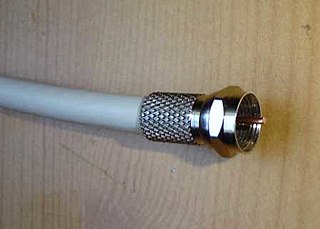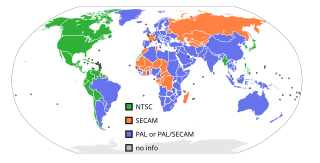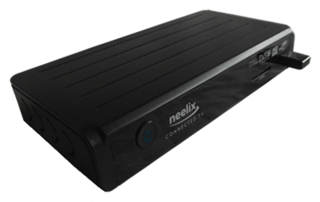Related Research Articles

Analog television is the original television technology that uses analog signals to transmit video and audio. In an analog television broadcast, the brightness, colors and sound are represented by amplitude, phase and frequency of an analog signal.

Cable television is a system of delivering television programming to consumers via radio frequency (RF) signals transmitted through coaxial cables, or in more recent systems, light pulses through fibre-optic cables. This contrasts with broadcast television, in which the television signal is transmitted over-the-air by radio waves and received by a television antenna attached to the television; or satellite television, in which the television signal is transmitted over-the-air by radio waves from a communications satellite orbiting the Earth, and received by a satellite dish antenna on the roof. FM radio programming, high-speed Internet, telephone services, and similar non-television services may also be provided through these cables. Analog television was standard in the 20th century, but since the 2000s, cable systems have been upgraded to digital cable operation.

Digital television (DTV) is the transmission of television signals using digital encoding, in contrast to the earlier analog television technology which used analog signals. At the time of its development it was considered an innovative advancement and represented the first significant evolution in television technology since color television in the 1950s. Modern digital television is transmitted in high-definition television (HDTV) with greater resolution than analog TV. It typically uses a widescreen aspect ratio in contrast to the narrower format (4:3) of analog TV. It makes more economical use of scarce radio spectrum space; it can transmit up to seven channels in the same bandwidth as a single analog channel, and provides many new features that analog television cannot. A transition from analog to digital broadcasting began around 2000. Different digital television broadcasting standards have been adopted in different parts of the world; below are the more widely used standards:

NTSC is the first American standard for analog television, published in 1941. In 1961, it was assigned the designation System M. It is also known as EIA standard 170.

A set-top box (STB), also known as a cable box or receiver and historically television decoder or a converter, is an information appliance device that generally contains a TV-tuner input and displays output to a television set and an external source of signal, turning the source signal into content in a form that can then be displayed on the television screen or other display device. They are used in cable television, satellite television, and over-the-air television systems as well as other uses.
In radio communication, multipath is the propagation phenomenon that results in radio signals reaching the receiving antenna by two or more paths. Causes of multipath include atmospheric ducting, ionospheric reflection and refraction, and reflection from water bodies and terrestrial objects such as mountains and buildings. When the same signal is received over more than one path, it can create interference and phase shifting of the signal. Destructive interference causes fading; this may cause a radio signal to become too weak in certain areas to be received adequately. For this reason, this effect is also known as multipath interference or multipath distortion.

The Great Central Railway in England was formed when the Manchester, Sheffield and Lincolnshire Railway changed its name in 1897, anticipating the opening in 1899 of its London Extension. On 1 January 1923, the company was grouped into the London and North Eastern Railway.

Terrestrial television or over-the-air television (OTA) is a type of television broadcasting in which the content is transmitted via radio waves from the terrestrial (Earth-based) transmitter of a TV station to a TV receiver having an antenna. The term terrestrial is more common in Europe and Latin America, while in Canada and the United States it is called over-the-air or simply broadcast. This type of TV broadcast is distinguished from newer technologies, such as satellite television, in which the signal is transmitted to the receiver from an overhead satellite; cable television, in which the signal is carried to the receiver through a cable; and Internet Protocol television, in which the signal is received over an Internet stream or on a network utilizing the Internet Protocol. Terrestrial television stations broadcast on television channels with frequencies between about 52 and 600 MHz in the VHF and UHF bands. Since radio waves in these bands travel by line of sight, reception is generally limited by the visual horizon to distances of 64–97 kilometres (40–60 mi), although under better conditions and with tropospheric ducting, signals can sometimes be received hundreds of kilometers distant.

Advanced Television Systems Committee (ATSC) standards are an International set of standards for broadcast and digital television transmission over terrestrial, cable and satellite networks. It is largely a replacement for the analog NTSC standard and, like that standard, is used mostly in the United States, Mexico, Canada, South Korea and Trinidad & Tobago. Several former NTSC users, such as Japan, have not used ATSC during their digital television transition, because they adopted other systems such as ISDB developed by Japan, and DVB developed in Europe, for example.

The Great Central Railway (GCR) is a heritage railway in Leicestershire, England, named after the company that originally built this stretch of railway. It runs for 8.25 miles (13.28 km) between the town of Loughborough and a new terminus in the north of Leicester. It has period signalling, locomotives and rolling stock.
Broadcasttelevision systems are the encoding or formatting systems for the transmission and reception of terrestrial television signals.
PALplus is an analogue television broadcasting system aimed to improve and enhance the PAL format by allowing 16:9 aspect ratio broadcasts, while remaining compatible with existing television receivers, defined by International Telecommunication Union (ITU) recommendation BT.1197-1. Introduced in 1993, it followed experiences with the HD-MAC and D2-MAC, hybrid analogue-digital widescreen formats that were incompatible with PAL receivers. It was developed at the University of Dortmund in Germany, in cooperation with German terrestrial broadcasters and European and Japanese manufacturers. The system had some adoption across Europe during the late 1990s and helped introduce widescreen TVs in the market, but never became mainstream.

A single-frequency network or SFN is a broadcast network where several transmitters simultaneously send the same signal over the same frequency channel.

A television antenna is an antenna specifically designed for use with a television receiver (TV) to receive over-the-air broadcast television signals from a television station. Television reception is dependent upon the antenna as well as the transmitter. Terrestrial television is broadcast on frequencies from about 47 to 250 MHz in the very high frequency (VHF) band, and 470 to 960 MHz in the ultra high frequency (UHF) band in different countries. Television antennas are manufactured in two different types: "indoor" antennas, to be located on top of or next to the television set, and "outdoor" antennas, mounted on a mast on top of the owner's house. They can also be mounted in a loft or attic, where the dry conditions and increased elevation are advantageous for reception and antenna longevity. Outdoor antennas are more expensive and difficult to install but are necessary for adequate reception in fringe areas far from television stations. The most common types of indoor antennas are the dipole and loop antennas, and for outdoor antennas the Yagi, log periodic, and for UHF channels the multi-bay reflective array antenna.
The 405-line monochrome analogue television broadcasting system was the first fully electronic television system to be used in regular broadcasting. The number of television lines influences the image resolution, or quality of the picture.
Television interference (TVI) is a particular case of electromagnetic interference which affects television reception. Many natural and man-made phenomena can disrupt the reception of television signals. These include naturally occurring and artificial spark discharges, and effects due to the operation of radio transmitters.

In television, a ghost is a replica of the transmitted image, offset in position, that is superimposed on top of the main image. It is often caused when a TV signal travels by two different paths to a receiving antenna, with a slight difference in timing.
ATSC-M/H is a U.S. standard for mobile digital TV that allows TV broadcasts to be received by mobile devices.
ATSC 3.0 is a major version of the ATSC standards for terrestrial television broadcasting created by the Advanced Television Systems Committee (ATSC).
Clear-Vision is a Japanese EDTV television system introduced in the 1990s, that improves audio and video quality while remaining compatible with the existing broadcast standard. Developed to improve analog NTSC, it adds features like progressive scan, ghost cancellation and widescreen image format. A similar system named PALPlus was develop in Europe with the goal of improving analog PAL broadcasts.
References
- ↑ "The Museum of Broadcast Communications - Encyclopedia of Television - Advanced Television Systems Committee". www.museum.tv. Archived from the original on 2013-12-25.